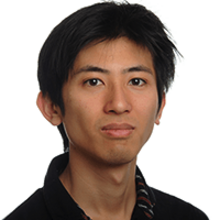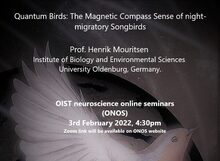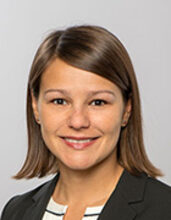Past Events
[ONOS Seminar Series] Professor. Michael A. Long: Neural mechanisms of interactive communication
2023年6月15日 (木) 9:30[ONOS Seminar Series] Professor. Michael A. Long
Title: Neural mechanisms of interactive communication
Join the ZOOM from the link here!
[ONOS Seminar Series] Professor Jimmy Dooley : How movements during sleep teach infant brains how their bodies move
2023年4月20日 (木) 10:00OIST Neuroscience Club is excited to host Prof. Jimmy Dooley from the department of biological sciences, Purdue University, USA. If you are interested in knowing how slight twitchy movements during your sleep in your infancy shape your brain, make sure to join the seminar!
[Seminar] Professor Gabrielle Girardeau: Neural mechanisms for memory and emotional processing during sleep
2022年5月12日 (木) 17:00
[Neuroscience Club] Prof. Gabrielle Girardeau, Principal Investigator, CRCN Inserm / Sorbonne University
[Seminar] Professor Hidehiko Inagaki: A midbrain-thalamus-cortex circuit reorganizes cortical dynamics to initiate planned movement
2022年4月21日 (木) 12:00[Neuroscience Club] Prof. Hidehiko Inagaki, Research Group Leader, Neural Dynamics & Cognitive Functions Group
We are excited to have an online seminar by Prof. Inagaki from Max Plank Florida Institute for Neuroscience.
You can join the seminar via ZOOM (meeting ID: 782 721 4941, Password: 436475).
Quantum Birds: The Magnetic Compass Sense of night-migratory Songbirds
2022年2月3日 (木) 16:30Quantum Birds: The Magnetic Compass Sense of night-migratory Songbirds
Prof. Henrik Mouritsen
Institute of Biology and Environmental Sciences, University Oldenburg,
Prof. Mouritsen will present how night-migratory songbirds seem to use a quantum mechanical mechanism to sense magnetic compass information which they use to navigate with exquisite precision over thousands of kilometres (Mouritsen 2018). In the past years, evidence has mounted that migratory birds use a light-dependent, radical pair-based mechanism to sense the axis of the geomagnetic field lines (Hore & Mouritsen 2016). The magnetic compass of night-migratory birds is sensitive to anthropogenic electromagnetic field disturbances being ca. 1000 times weaker than the current WHO guideline limits (Engels et al. 2014; Schwarze et al. 2016). This result could be significant in relation to migratory bird conservation measures and strongly indicates that the basic sensory mechanism underlying the magnetic compass of night-migratory songbirds should be based on quantum mechanical principles rather than classical physics. Neuroanatomical data have shown that magnetic compass information is detected in the eye and then processed in a small part of the thalamofugal visual pathway terminating in the visual processing centre “Cluster N” (Mouritsen et al. 2005; Liedvogel et al. 2007; Feenders et al. 2008; Zapka et al. 2009). When Cluster N is deactivated, migratory European Robins can no longer use their magnetic compass, whereas their star compass and sun compass abilities are unaffected (Zapka et al. 2009). The lagena and associated pathways remained intact. Bilateral section of the trigeminal nerve had no effect on the birds’ ability to use their magnetic compass (Zapka et al. 2009). Very recently, we could also show that the light-sensitive protein Cryptochrome 4 from a night-migratory songbird is magnetically sensitive in vitro based on a radical-pair mechanism (Xu et al. 2021).
Zoom link
https://oist.zoom.us/j/97850326939
Notes from Underground: vocal communication in a eusocial rodent
2021年11月25日 (木) 16:00Notes from Underground: vocal communication in a eusocial rodent
Naked mole-rats are exceptionally long-lived (reported lifespans > 30 years), highly resistant to cancer and low oxygen conditions and live in colonies organized to support a single breeding female, queen. This type of social behavior is rare among mammals, although commonly found in the social insects: bees, wasps, and ants. Yet how naked mole-rats organize and maintain their elaborate social groups is largely unknown. Recent work from our group identified a critical role for vocal communication in naked mole-rats societies. Using machine learning techniques, we developed methods to automatically classify and analyze features of one vocalization type, the soft chirp, a greeting call used by naked mole-rats when they encounter one another in their subterranean habitat. We demonstrated that soft chirps encode information about individual and colony identity, suggesting the possibility of colony specific dialects. In a series of behavioral tests, we found that vocal responses were enhanced to home colony vs. foreign colony audio playbacks and to artificially generated colony-specific dialects. We further demonstrated that these dialects can be learned, as pups that were cross-fostered early in life acquired the dialect of their adoptive colonies. Colony specificity of vocal dialects is controlled in part by the presence of the queen: when the queen was lost the vocal cohesiveness of the colony dialect disintegrated. In this lecture I will highlight some of the remarkable lessons we can learn from the naked mole-rat including how vocal communication emerges as an evolutionary mechanism for enhanced cooperation.
Neuroscience with Gordon Arbuthnott
2021年11月4日 (木) 10:00The OIST Neuroscience Club would like to invite you to a special presentation by Prof. Gordon Arbuthnott. For his last public presentation, he will give a talk about his journey as a neuroscientist: past, present, and future.
Emergence of organization and computation in neural circuits
2021年10月28日 (木) 16:00Prof. Dr. Julijana Gjorgjieva
Assistant Professor in Computational Neuroscience, Max Planck Institute for Brain Research, Technical University of Munich
The emergence of organization and computation in neural circuits
How neural circuits become organized during early postnatal development based on patterns of spontaneous activity and different plasticity mechanisms. Prof. Julijana will show the emergence of organization at the sub-cellular and cellular level and discuss implications for computations implemented by these networks. These theoretical models and simulations are supported by experimental data and make numerous predictions for future experiments.
Passcode: 959053
[Seminar] Intrinsic Reward in Birdsong Learning, Prof. Hahnloser
2021年5月27日 (木) 16:00Professor Richard Hahnloser
Institute of Neuroinformatics,
University of Zurich and ETH Zurich
Zoom link: https://oist.zoom.us/j/98260915981?pwd=dWNFRVQrcUhCNWhrbGhtYWs0TEZPUT09
Passcode: 959053
Inter-Unit Neuroscience Journal Club
2021年2月25日 (木) 16:30In our first monthly journal club meeting of 2021, Professor Gordon Arbuthnott of the Brian Mechanisms for Behaviour presents a recently published study: Striatal Bilateral Control of skilled forelimb movement. Everyone is welcome to join online.











